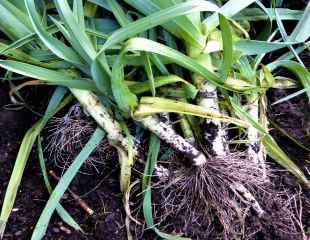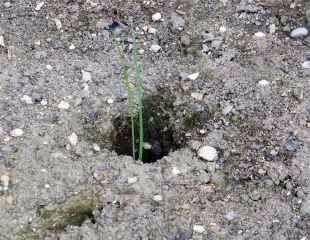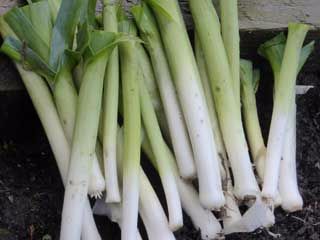


How to Grow Leeks
Home-grown leeks are lovely, more sweet in flavour and softer than shop bought. Leeks are available to pick over a long season from summer baby Leeks right through to the winter crops. In common with all the edible Alliums, onions, garlic and chives, Leeks are reliable and one of the easiest of veg to grow. Leeks require patience. I love growing Leeks even though they must be the slowest growing of all vegetables. For this reason, they are best planted in a corner of the veg plot and then forgotten about for many months, but well worth the wait.
Leeks are a frost hardy veg and can be left in the veg plot late in the year and overwinter. Leeks are easy to raise from seed, but because they are so slow growing, it is often easier to buy them as baby plants to get a bit of a head start on the growing season.
Growing Leeks from Seed
If you are growing Leeks from seed, you need to get started early and start in Feb/March and select an early or mid-season variety, (marked on the packet.) Leeks do not require extra heat to germinate, they are a hardy vegetable and will germinate in cool conditions. To maximise growth, Leeks are best started under glass or in a greenhouse in small pots. Leek seedlings will tolerate cool/cold conditions, but if a real cold spell arrives and temperatures plummet, protect the seedlings from the coldest of nights and frosts with a horticultural fleece.
Each seedling should be about 2.5cms (1") apart whilst growing on in a pot. When you seed Leeks, check them out as some will (inevitably) be better seedlings than others and dispose of the weedy seedlings and keep only the best. Sow two or three times successively to stagger when the leeks will come to maturity for harvesting and that way you can harvest Leeks over a long period.
Packets of Leek seeds can contain hundreds of seeds. The good news is that Leeks seeds will keep for several years. To store seed at its best place in sealed metal container and keep in cool dark place such as a fridge.
Alternately, you can skip the germination stage and buy small plants around May/June for planting out.
How to plant out Leeks
Ideally, you want to grow Leeks in a way that produces a nice white stem of a decent size. The white stem is the part of the Leek grown underground. Leeks are shallow rooted, which means their scope for drawing water is more limited. This means it is important during growing that Leek plants do not dry out and are best watered during dry spells.
The aim is to grow the Leeks under glass/in a lean to/poly tunnel until they are about the size and width of a pencil, at which point they are ready for planting out. This usually takes around 10 weeks or so by which stage the Leeks should also have a good, well-developed root system.
Plant out around late May /June or at the latest July. Some growers like to trim the Leeks before planting out. This means trimming back the roots a little at this stage, the roots maybe 10cms long and straggling. Trimming the roots makes it easier to insert the Leek into the hole, and deeper (which is important for a good white stem.) To do this, cut roots by about a half. In addition, you can cut about half of the top leaf growth, which will reduce the water loss of the Leek once planted. This is not essential, but by preparing the Leek for planting outside in this way makes it easier to plant and helps it get off to a good start.
When planting out Leeks make individual holes for each Leek at least 15 cmc (6") deep with a large dibber, or stick, and drop the Leek into it. The reason to plant deeply is so that much of the Leek drops into the hole and is underground, which will cause it to blanch and form the white stem, which is the nicest part of the Leek for cooking. This is why trimming the roots of the Leek helps, so the Leek can drop right down in the hole and you may find after planting 2/3rds under ground and 1/3 above soil level, which is good.
You do not need to fill the hole with soil, or firm in the Leeks, and you don't. Water the hole well known as puddling in, and this will cause the soil to draw in around the Leek, see centre image. Do not add soil, and it is unnecessary to fill the hole in as it will fill in over time especially with rain and watering, and at this stage, there will be enough soil after planting (and watering) to enable to Leek to root down firmly.
Plant Leeks about 20-22cms apart minimum, if you have more space up to 30cms which will make for fatter, larger Leeks. Each row should be 30-38 cm apart (12-15") When planting out Leeks as small plants, make sure the hole is deep enough when you plant out and water well after planting.
To increase the white stems, once the Leek has put on some growth and more Leek is showing above soil level, draw the soil up the stem of the Leek as it grows. Take care not to allow soil to get into the Leek when earthing up, as this will make for a gritty Leek harvest. Some keen growers will plant Leeks into a trench to give more scope for earthing up as the growing season progresses.
Leeks are grown as early and late varieties, which, as the name suggests, harvest earlies Sept- December and later varieties into the winter. To get a harvest starting in Septembe and over winter, Leeks need to be in the ground by June. You can commence harvesting earlier as baby Leeks.
As with all crops, rotation is helpful, and Leeks are members of the Allium family ( which are also ornamental) , the onion, which means they are best grown in a part of the plot which didn't have onions or garlic grown in it the previous year.
Leeks are hardy and can be left in the ground through the winter, enabling you to pick them as and when need. You can pick a few and leave the smaller ones in the ground and they will continue to grow during mild spells over the winter.
Leeks are generally trouble free, their only requirement once planted out is to be watered regularly, which helps to avoid bolting, especially in dry spells. The other occasional problem with Leeks is rust. Do not be tempted to plant Leeks too close together. Air circulation helps to avoid the problem with rust.
Good varieties of Leeks to grow
The RHS undertook a trial of Leeks to consider the Award of Garden merit. The trial was Autumn and Early Winter 2015-2016 and in Autumn 2017, the results were published. They rated plants for vigour, leaf habit, colour and disease, the principle culprit here being Leek rust. The leeks were lifted and reviewed with a result that 10 leeks have the RHS award, of which two re reconfirmed. All have hardiness rating of H4 or H5 .
Those which did well in the trial and recommended are: 'Belton', 'Cairngorm' described as more like a show leek which sounds impressive; 'Krypton' 'Portbella', and 'Runner'. Reconfirmed in their status as were 'Jolant' and 'Oarsman'
I usually grow the widely available Mussleburgh with good results illustrated above.
Leek Diseases
Leek Rust is the most common problem which stains the leaves' bright orange patches. It is more common in wet spells and there is no remedy. Modest attacks will still make the crop viable and the best preventive step is not to plant leeks to close together. If it occurs, rotate your crops, and do not plant any Alliums for 3 years.
Problems have been reported from Leek moth, which more common in the south of the England. The caterpillars tunnel into the leeks and causing damage. Again, there is no remedy except to remove the caterpillars and infected leaves.

Leeks are easy to grow but need a little attention in planting and watering .
